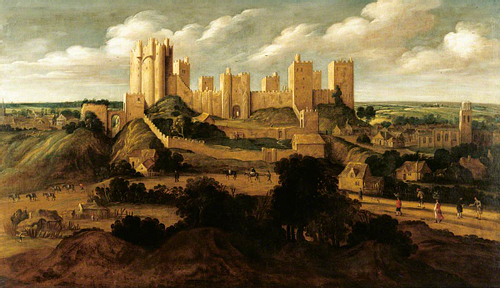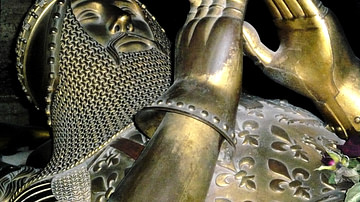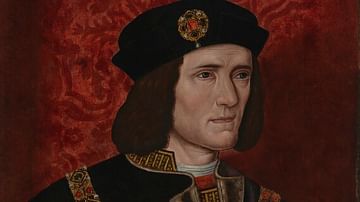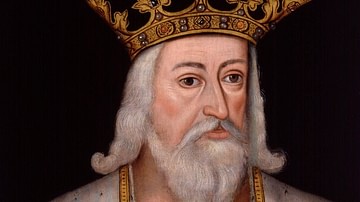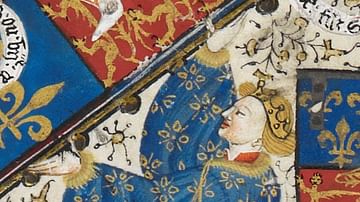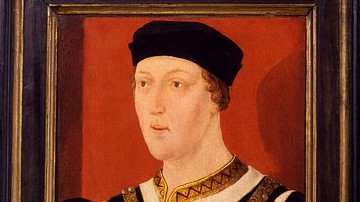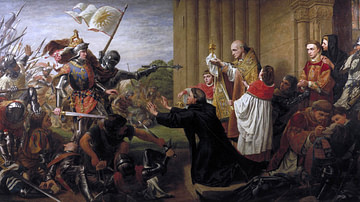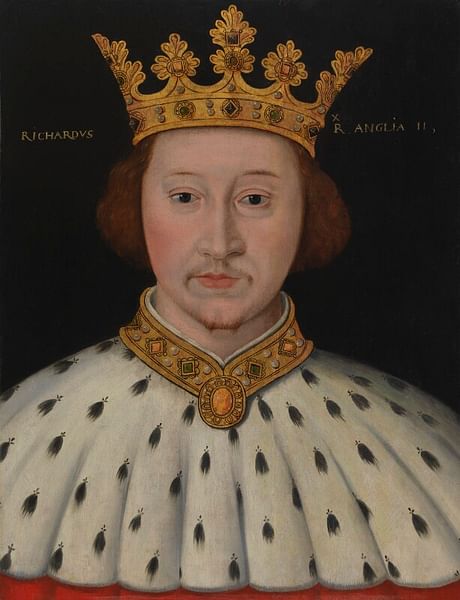
Richard II of England reigned as king from 1377 to 1399 CE. The son of the late Edward the Black Prince (1330-1376 CE), Richard would succeed his grandfather Edward III of England (r. 1327-1377 CE), but as he was only 10 years of age, he initially had to co-rule with his most powerful barons. The Peasants' Revolt of June 1381 CE was successfully put down but a failed campaign in Scotland, misguided favouritism at court, and the ambition of certain rival nobles all conspired to limit the power of a king who had, unwisely, considered himself divinely chosen to rule any way he wished. In August 1399 CE Richard was imprisoned, and the following February he was murdered and succeeded by his cousin and rival Henry Bolingbroke, Duke of Lancaster, who became Henry IV of England (r. 1399-1413 CE)
Family & Succession
Edward of Woodstock, better known as the Black Prince after his distinctive armour or martial reputation, was the eldest son of Edward III of England. Made the Prince of Wales in 1343 CE and one of the greatest of all medieval knights, Edward would not, however, become king. The Black Prince died, probably of dysentery, on 8 June 1376 CE and so Parliament selected as the official heir to Edward III the prince's surviving son Richard of Bordeaux (b. 6 January 1367 CE). The young king-to-be's mother was Joan, the countess of Kent (1328-1385 CE), and he had had one brother, Edward, who had died in 1371 CE. Richard was favoured over another of Edward III's sons, John of Gaunt (1340-1399 CE), the Duke of Lancaster, largely because the latter had supported a number of officials and nobles identified by Parliament as guilty of corruption and misrule. As planned then, when Edward III died on 21 June 1377 CE, Richard became king.
Richard was crowned on 16 July 1377 CE at Westminster Abbey, but he was a mere 10 years old and so his troubled kingdom was governed by a revolving council of nobles. The Hundred Years' War between England and France (1337-1453 CE) had started remarkably well for England with great victories at Crécy (1346 CE) and Poitiers (1356 CE) but by 1375 CE Charles V of France, aka Charles the Wise (r. 1364-1380 CE), had ensured that the only lands left in France belonging to the English Crown were Calais and a thin slice of Gascony. The war with France and its ally Scotland had also taken a heavy financial toll on the kingdom with an incessant round of taxes inflicted on the people, a situation only worsened by the arrival of the Black Death in 1348 CE which brought death and economic ruin. The failure to take the military initiative against France, high taxes and lasting economic disruption would all come back to haunt Richard later in his reign.
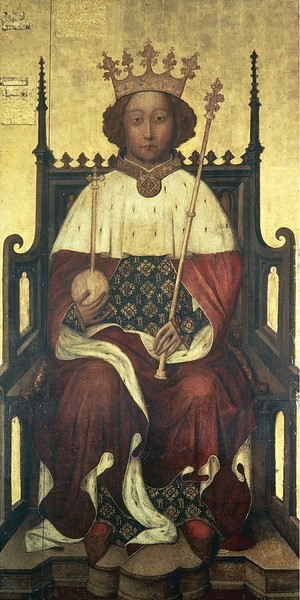
Peasants' Revolt
The so-called Peasants' Revolt of June 1381 CE was the most infamous popular uprising of the Middle Ages. The trouble started when a group of yeomen from Kent and Essex, fed up with the problem caused by the Black Death plague and, above all, the never-ending taxes which, since 1377 CE, included poll taxes of three groats (one shilling) aimed at everyone irrespective of resources, marched to protest in London. The group, numbering several thousand, caused havoc on the way as they looted, pillaged, and murdered. When the mob got to London, they burnt down the Savoy palace of the Duke of Lancaster and murdered anyone they pleased - the Chancellor, Archbishop Simon of Sudbury would be one victim, decapitated on Tower Hill. The mob's demands for change included the abolition of serfdom, a repeal of the laws limiting wage increases brought in after the Black Death, more peasant participation on local government, and the redistribution of the Church's riches (the latter being an idea championed by the theologian John Wycliffe, c. 1325-1384 CE). Although only 14, King Richard bravely met the protestors at Smithfield outside London on 15 June and persuaded them to stand down. This was quite a feat considering William Walworth, the Mayor of London stepped forward and killed Wat Tyler, one of the rebel leaders, amongst the confusion, perhaps thinking Tyler was about to do the king harm. Richard had, nevertheless, stepped forward and boldly declared:
Sirs, would you kill your king? I am your rightful captain, and I will be your leader. Let all those who love me, follow me.
(Quoted in Jones, N., 75)
Richard then employed the much-used tactic of making a load of extravagant promises he had no intention of keeping, but it was enough to stave off more rioting and the mob disbanded. Utterly ruthless, Richard ensured that around 150 of the rebels were hanged. There were other minor outbreaks of rebellion thereafter, but these were mercilessly quashed and their ringleaders executed as traitors.
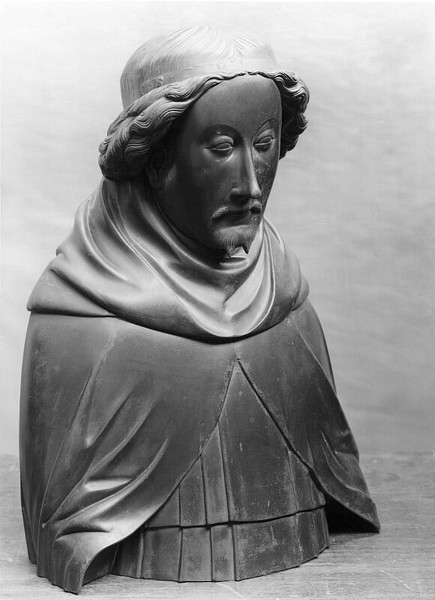
The Merciless Parliament
Richard II may have won accolades for his success in putting down the Peasants' Revolt but any hopes that England had found itself a fine king, true and just, were soon dashed. The young monarch was wilful and hot-tempered, and he turned out to be rather too confident in his divine right to rule, making him intolerant of any views that conflicted with his own. Ignoring his barons, Parliament and commoners alike, Richard largely preferred to spend his time with favourites like Robert de Vere, Earl of Oxford and his circle of sycophants.
Medieval kings were often expected to perform great deeds on the battlefield but Richard's single campaign in Scotland in 1385 CE was a damp squib with no contact being made with the enemy. In 1388 CE, one of the great medieval knights, Sir Henry 'Hotspur' Percy (1364-1403 CE) led an army against the Scots but was soundly defeated at the Battle of Otterburn. Sir Henry even suffered the ignominy of capture and being set up for ransom, which Parliament and King Richard did meet.
Richard had a much bigger crisis to deal with at home when, in 1386 CE, he made the hugely unpopular de Vere the Duke of Ireland and it looked like France was preparing to invade England. In December 1387 CE the dissatisfied barons made their move by defeating de Vere and his supporters at the Battle of Radcot Bridge near Oxford. Led by such high figures as Thomas Woodstock, the Duke of Gloucester (the king's uncle) and Henry Bolingbroke (b. c. 1366 CE, the king's cousin and son of John of Gaunt), a group of five barons next formed a council known as the Lords Appellants to better manage the king, still then considered a minor. This council called a Parliament in 1388 CE, which became known as the 'Merciless Parliament' and which essentially installed the Lords Appellants as the rulers of England who insisted Richard retake his coronation oath and who purged the royal court of anyone they considered undesirable.
Patron of the Arts
Richard, who reached maturity in 1389 CE, wisely opted for a low political profile and retreated into the arts by appointing his own circle of similarly-minded friends at court. The king may have resisted the temptation to persecute those who had earlier been against him but one thing which he could not desist from was his continuing love of pomp and ceremony. Glorifying his own image, it seemed Richard was in love with himself as king and now even insisted he be addressed as 'Your Majesty' or 'Your Highness' rather than the traditional 'My lord'. Perhaps significantly, Richard was the first English king to have his portrait painted while still alive; the artist chosen for this honour may have been Andre Beauneveu of Valenciennes (1335-1400 CE). The finished painting was hung in Westminster Abbey and shows the king in full regalia.
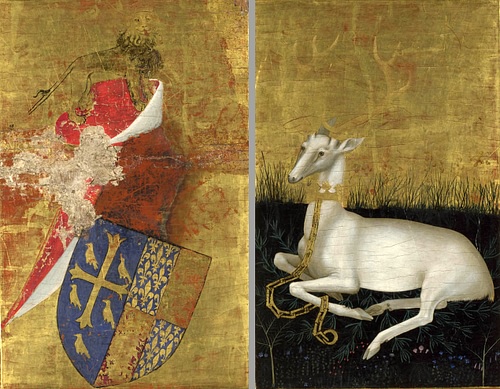
Richard's tournament device was a white hart or stag which became an emblem for his supporters to wear as a mark of identification and as part of his servants' livery. Richard revamped Westminster Palace in 1393 CE at vast expense, making the interior much more colourful. Westminster Hall received a new roof, statues of various kings were added, and Richard's white harts appeared at the bases of the windows. Meanwhile, the Tower of London was refurbished, too, and expensive stained glass added. The king also supported medieval literature, especially the poet Geoffrey Chaucer (1343-1400 CE) who was made Clerk of the King's Works in 1389 CE, a position which saw him in charge of royal properties.
Ireland & France
In 1394 CE Richard led an army to Ireland, a very rare deed for an English king, but the campaign was inconclusive. 80 Irish chiefs did pay homage to the king, and English claims to lands there were recognised. Relations improved with France on 12 March 1396 CE, though, when the king married Isabella of France, the daughter of Charles VI of France (r. 1380-1422 CE). Isabella was only seven, but it was a union which cemented a three-decade truce between the two countries. Richard had been previously married to Anne of Bohemia, the daughter of Holy Roman Emperor Charles IV (r. 1346-1378 CE) from 1382 CE, but she died in June 1394 CE, probably of plague. Neither of these marriages produced any children, something which would be exploited by Richard's enemies. The arrangement with Charles VI did not include Richard giving up his claim to the French throne (a claim which began with Edward III) and so the Hundred Years' War was, for now, merely put on pause.
The Return of Bolingbroke
In 1397 CE, perhaps feeling more secure on his throne and giving vent to the taste for vengeance so many medieval monarchs enjoyed, Richard, at last, began to plot against those who had betrayed him ten years before. The king had the Lords Appellants, including Bolingbroke, arrested and either exiled or executed; their estates becoming useful gifts for others at court or the Crown itself. Many barons now realised the king was tyrannical and that nobody was safe from his whims.
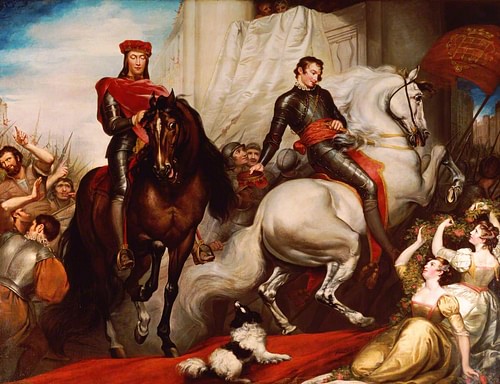
In 1399 CE, Richard then made his fatal mistake. The king had a hankering to continue his unfinished business in Ireland but while there, Bolingbroke, seen by some as the legitimate heir to Edward III now that his father John of Gaunt was dead (3 February 1399 CE), returned from his exile in France. In June-July 1399 CE Bolingbroke only had a small invading army, perhaps 300 fighting men, which landed at Spurn Head in Yorkshire. Fortunately for Bolingbroke, the English barons, who included such figures as Sir Henry 'Hotspur' Percy, were only too pleased to switch their allegiance to the usurper, and the rebel army swelled as it moved south, and the king's support evaporated.
Richard returned from Ireland but wisely went into hiding in Conwy Castle in Wales. The king was then tricked into giving himself up on 20 August and was imprisoned in the Tower of London, the first English monarch to be confined there. On 29 September 1399 CE, Bolingbroke next forced Richard to sign a formal document of abdication, another dubious first in English history. The wording of this document was as follows:
I Richard by the grace of God king of England and of France and lord of Ireland…resign all my kingly majesty, dignity and crown…And with deed and word I leave off and resign them and go from them for evermore, for I know, acknowledge and deem myself to be, and have been, insufficient, unable and unprofitable, and for my deserts not unworthily to be put down.
(quoted in Jones, N., 80-81)
William Shakespeare (1564-1616 CE) in his play Richard II has the king utter the rather more realistic sentiments regarding his demise:
My God! A wonderful land is this, and a fickle; which hath exiled, slain, destroyed or ruined so many kings, rulers, and great men, and is ever tainted and toileth with strife, and variance and envy.
(ibid, 81)
Death & Successor
On 30 September Parliament officially nominated Henry Bolingbroke as Richard's successor. Richard was moved to his final place of confinement, Pontefract Castle in Yorkshire, in September 1399 CE, and there he died on 14 February 1400 CE. A failed uprising by Richard's supporters only sealed the ex-king's fate; he could not be allowed to live. Richard perhaps died of starvation or he was perhaps poisoned or he was even hacked to death by a squad of assassins, such are the varying theories on the king's quick demise. Richard was just 33 years of age, and his body was put on public display in the Tower of London in case any would-be rebels thought he might still be alive and ready to launch a coup. Eventually, Richard was interred in Westminster Abbey where his effigy can still be seen.
Meanwhile, Henry Bolingbroke was crowned Henry IV of England in Westminster Abbey on 13 October 1399 CE and he would reign until 1413 CE, although his time as king was beset with rebellions in both England and Wales. Henry was succeeded and outshone by his son Henry V of England (1413-1422 CE) who became one of the great fighting monarchs of European history but the ousting of the legitimate King Richard would come to haunt the Lancaster descendants as the two houses of Lancaster and York battled for the throne in what became known as the Wars of the Roses (1455-1487 CE).
